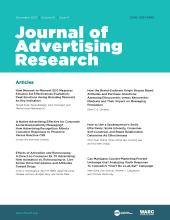Abstract
Drawing from the social-functional perspective, this research explored the differences in consumers’ responses to two types of spokesperson’s smile: broad and slight. The authors identified two boundary conditions: consumer self-construal (independent versus interdependent) and relationship norm (communal versus exchange). The results from two studies show that a spokesperson’s broad smile is more persuasive for consumers with interdependent self-construal in the communal relationship. By contrast, a spokesperson’s slight smile is more persuasive for consumers with independent self-construal in the exchange relationship. Processing fluency serves as the underlying mechanism. The results provide implications for marketers regarding how to use a spokesperson’s smile effectively.
- Received April 17, 2020.
- Received (in revised form) September 1, 2020.
- Accepted October 6, 2020.
- Copyright © 2021 ARF. All rights reserved.
ARF MEMBERS
If you are a member of the Advertising Research Foundation, you can access the content by logging in here
Log In
Pay Per Article - You may access this article (from the computer you are currently using) for 30 days for US$20.00
Regain Access - You can regain access to a recent Pay per Article purchase if your access period has not yet expired.





